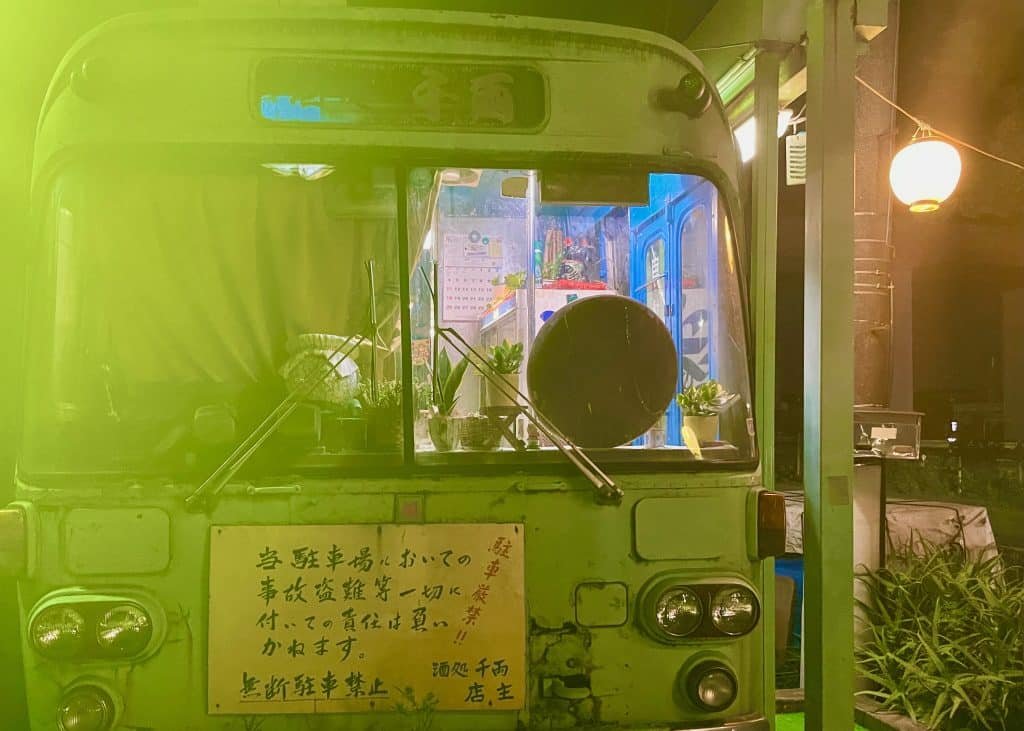Address: 4 Chome-343 Tatsube, Matsubara, Osaka 580-0012. Tel: 072-336-6353. Open 18:00-24:00. Closed: Sunday.
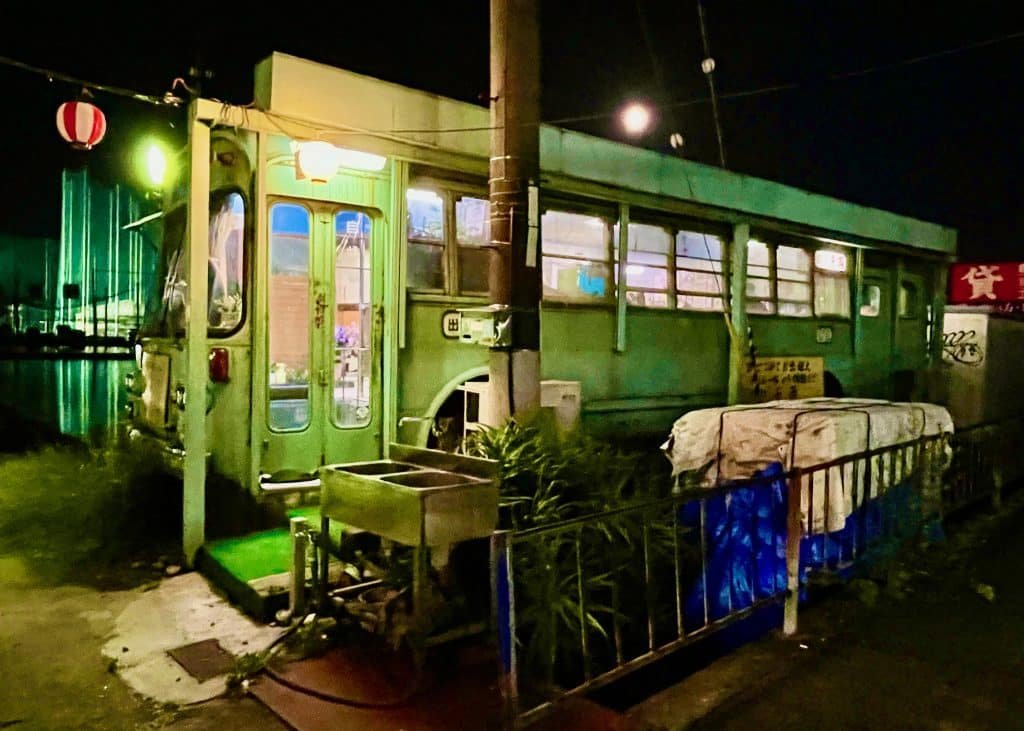
Table of Contents
Introduction
Senryo (酒処 千両) is an unique izakaya built inside of an old city bus that sits on a patch of land near a rice field on the side of the road under the Hanwa Expressway in Matsubara, a city located in the Kawachi district of Osaka Prefecture. Despite being a beloved neighborhood diner for more than 45 years, the eatery is still somewhat of an anaba—a local secret. One reason is that Senryo is not easy to get to without a car—it’s 1,320 meters away from the nearest rail station, Eganoshō Station on Kintetsu Minami Osaka Line in Habikino, which takes about 20 minutes on foot.
In the past the remote location would have been a deal-breaker for most visitors to Osaka, but travelers in Japan have become more adventurous and will seek out local spots far away from the bustling parts of the city that cater to tourists. Those who are willing to venture to this friendly off-the-beaten path restaurant will discover a wonderful selection of delicious tempura, seafood, udon, and other earthly delights prepared with expertise and served with care by a couple who have been married for over five decades.
History of Senryo
Senryo dates back to 1976. Tsuruo Takizawa was working as plasterer when he decided to quit his job and open an izakaya at the age of 30. He didn’t let the fact that he had never attended cooking school get in the way of his dream. His grandfather sold udon from a cart that he pulled along the streets and taught him to make broth using dashi. As an ardent rock fisherman, he learned to select the best types of fish.
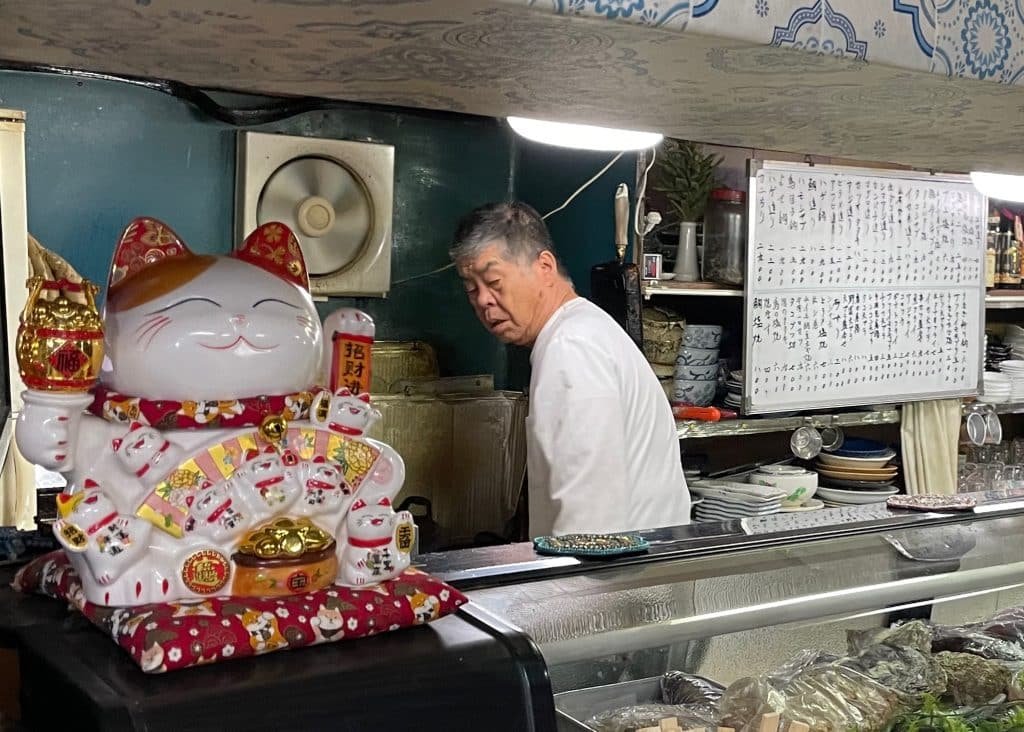
The married couple worked hard to improve their skills by obtaining a cooking license and becoming qualified in areas such a preparing fugu, a poisonous blowfish that can be deadly if not handled correctly. They also toured some of the best restaurants in Osaka to get menu ideas for their new restaurant.
Rather than sign a lease for a conventional property, the Takizawas purchased an old sightseeing bus in Nara that they gutted and remodeled. The couple did all the work with their own hands, except for the counter, which they had installed. They had to cut the body to install a downspout to drain rainwater away from the roof. When completed they found the bus to be much sturdier than the prefabricated structures that are often used for roadside establishments.
The patch of land that they chose for their new izakaya was located in a restricted zone in which residential housing was prohibited, but other structures such as warehouses were permitted. The unconventional location meant less overhead and more space for parking. While this set-up is hardly the norm, there were other “bus izakaya” on the property when the couple first started out, but none of them have lasted for close to half a century.
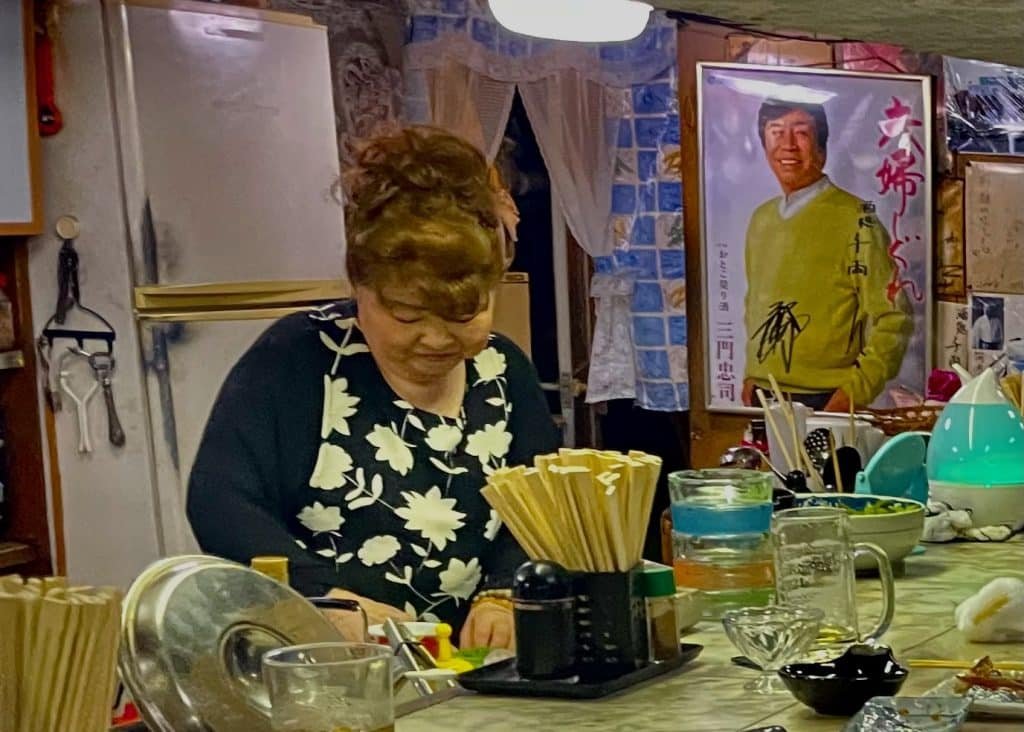
The original bus burned down in 1992, but Tsuruo and Harumi quickly rebuilt the restaurant using a decommissioned lime green Kongo Bus that used to take passengers from Tondabayashi Station to Mount Kongo in Chihayaakasaka-mura. They expanded the restaurant by adding a refrigerated shipping container, which includes a room that containes a horigotatsu or “sunken kotatsu,” which is perfects for small groups such as families who want to enjoy an intimate meal away from the main counter.
Get on The Bus
My wife and I had wanted to go to Senryo for years after spotting the izakaya on the side of rode, but it took several years before we finally got around to visiting the izakaya for the first time in 2021. During the day the bus and its jerry-rigged shipping container resembles something straight out of a post apocalyptic film such as Mad Max, but when lit up at night it there is a luminous green glow that has a serene quality especially under the moonlight. After parking we approached the entrance and followed instructions written on the door in red paint to press the button to open the door. We were then buzzed in greeted warmly by Tsuruo Takizawa with a hearty “irasshaimase!“
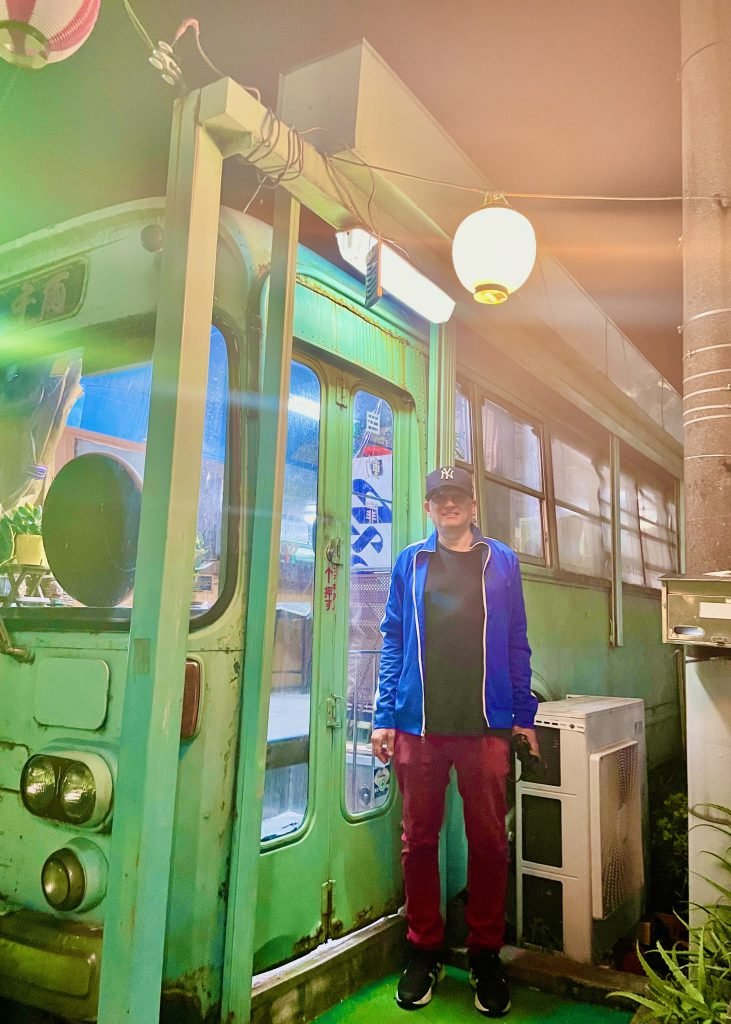
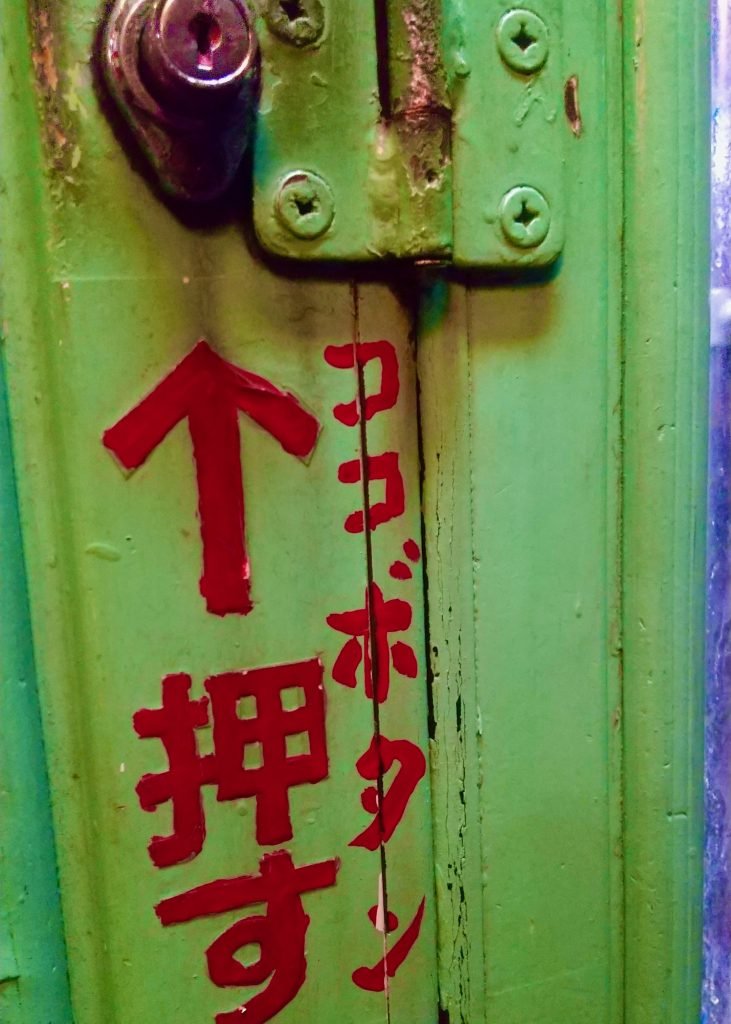
Upon entering I marveled at how the owners managed to fit so much stuff inside a city bus, but I discovered that the inside is actually quite cozy and tastefully decorated with assorted knicknacks such as manneki neko (beckoning cat), houseplants, and a couple of fish tanks, one that housed pet goldfish and the other that seemed to contain fish that were waiting to be served up for dinner. There was no sense whatsoever of being cramped inside a narrow space.
We were offered a choice of sitting at at the counter or at one of the five small tables by the windows. The counter, which sits around seven people, is on par with most small izakaya or standing bars and there was no need to inch by the other customers to find a seat. Naturally, we chose the counter so we could have a birdseye view of our food being prepared.
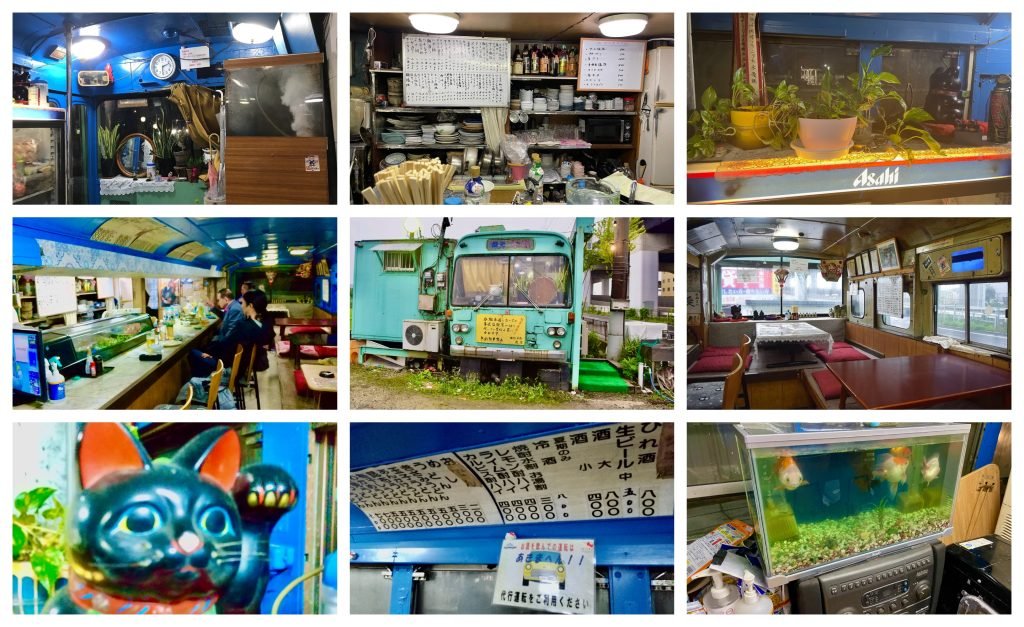
Another reason I like to sit at the counter is that it is a good way to get to know the owners and some of the regular customers. Keep in mind that there is no guarantee that the staff or the customers will be in the mood for a friendly chat. You just have to go with the flow and let things happen naturally. The first person we talked to at Senryo was an outgoing man in his 30s from Yokohama, who was working in Osaka away from his family—a practice which is known as tanshinfunin in Japanese
Meeting The “Chairman” of Senryo: a Loyal Customer in his 90s
The second customer we talked to was a well-dressed gentleman who told us that he was 94 years old (at the time). I don’t like to ask personal names of customers in bars even for journalistic purposes because its intrusive, but everyone called him Kaicho-san, which translates as “The Chairman” so I’ll use that in lieu of his real name. He told me he has been coming to Senryo every day for almost 45 years.
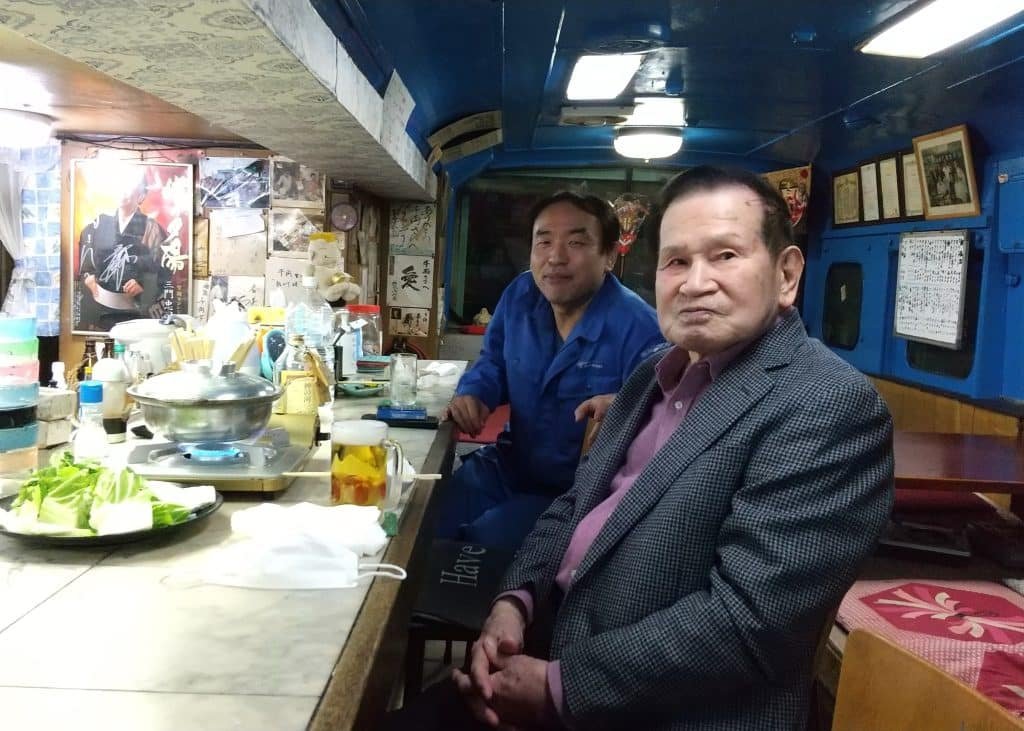
The Chairman said he loves the variety of menu and has never gotten tired of the food even after four decades. His son drops him off after work when Senryo opens and Tsuruo drives him home around 11:30 PM.
Every year the regulars come to Senryo to celebrate The Chairman’s birthday. For his 90th birthday the owners presented him with a commemorative DVD of the celebration. On the day of the event, enka singer Rikuro Kuroki, who is also a regular at Senryo, sang a special song he wrote for him called Sotsuju Ondo (90th Birthday Sing-a-long).
The Chairman told us that he was a member of the military while attending university but the war ended shortly before he was scheduled to be sent to the frontlines. I felt a sense of awe and honor to be in his presence in his home away from home, even for just a short amount of time.
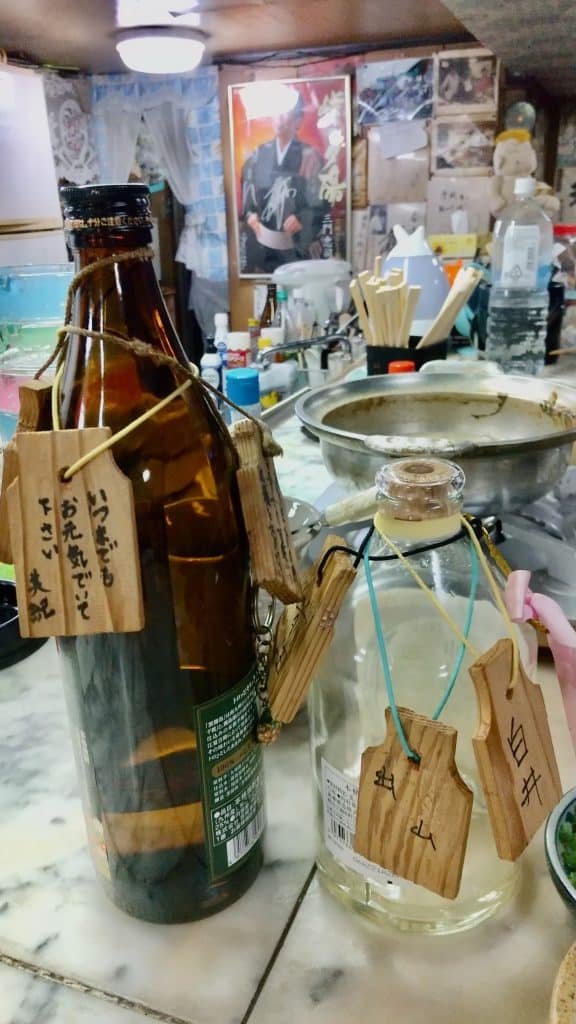
Update: We went back to Senryo in 2023 to celebrate my birthday. I was looking forward to meeting The Chairman for the first time in two years and when he didn’t show up I started to worry. I was relieved to learn that The Chairman still comes in every night and there was an explanation for his absence. It turns out he was at home celebrating his 96th birthday with his family. I hope to go back to Senryo soon to meet The Chairman and listen to more of his stories about the old days.
A Cornucopia of Food and Drink on The Bus
Most of the items on the food menu at Senryo are between 300 and 900 yen but expect to pay more for moriawase sets and nabe (hot pot) items that include expensive fish. I started off by ordering a draft beer (¥500/$3.35) and edamame. (My wife was the designated driver so she ordered oolong tea).
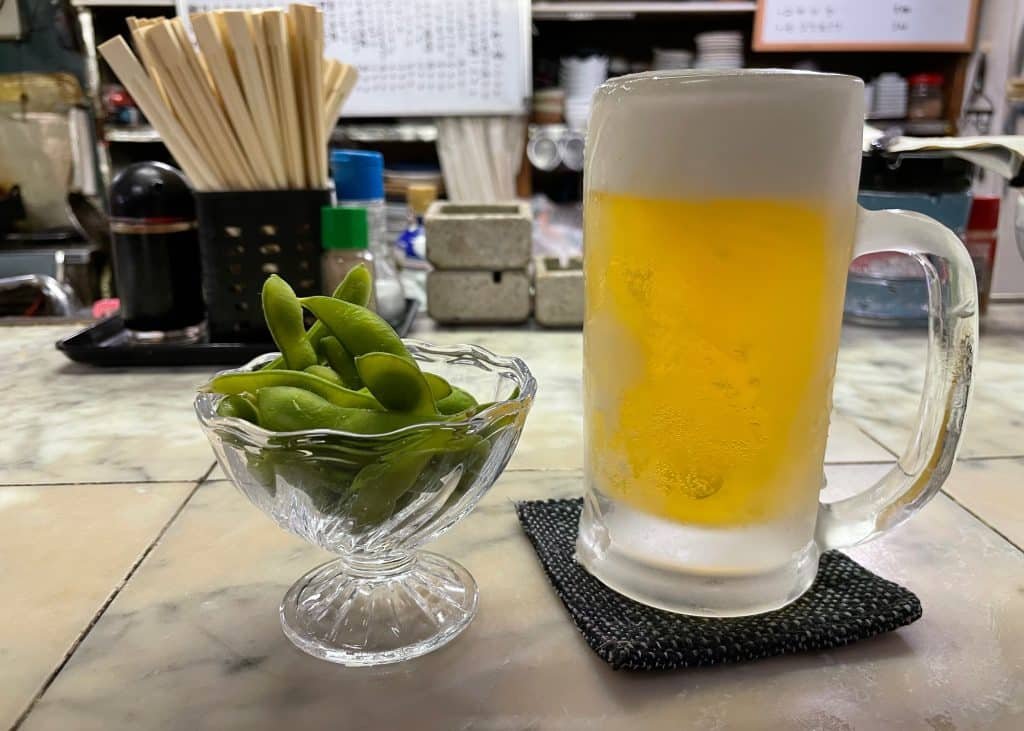
Normally I wouldn’t take the time to write about an ordinary major label draft beer, but this was poured to perfection in a chilled mug with ice particles on the side of the glass. More and more restaurants in Japan are switching to cheaper low-malt happoshu beer in order to combat runaway inflation, but there is nothing like a jar of the real thing, even if you have to pay slightly more.
Tempura Moriawase Set
I asked one of the customers for a recommendation and was told that we couldn’t go wrong with the tempura moriawase set for only 800 yen ($5.35). Sometimes it pays to ask a regular because this we really enjoyed this lightly battered set that contained two nice-sized jumbo shrimps and thick cuts of fresh crunchy vegetables such as lotus root, green peppers and pumpkin.
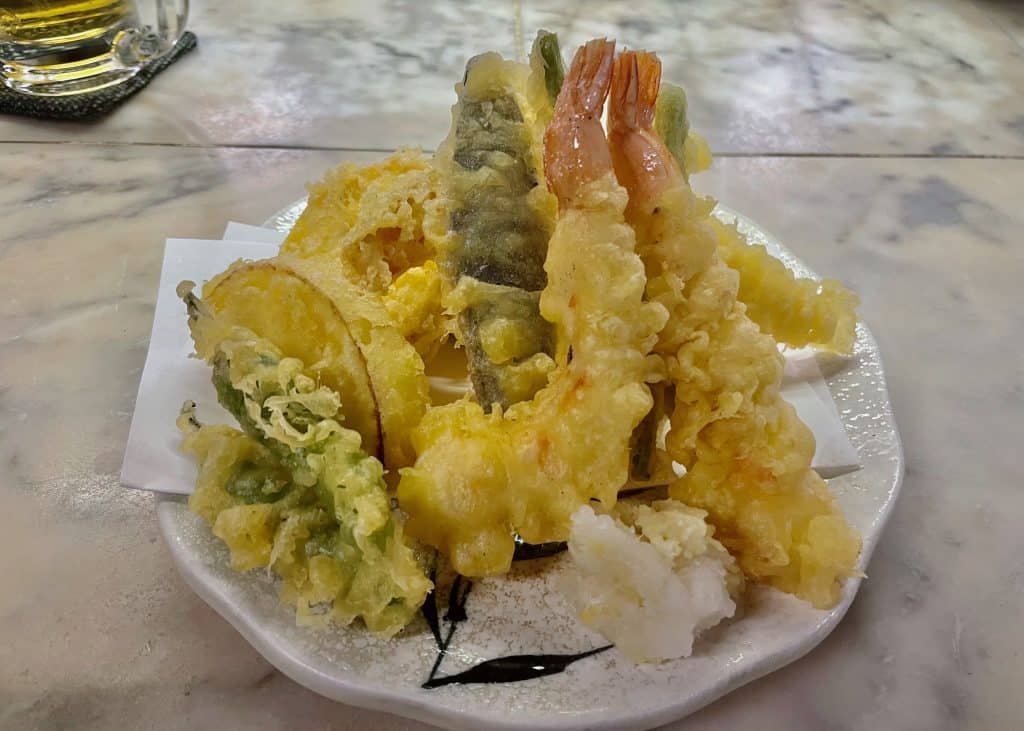
Sashimi Moriawase Set and Octopus Tempura
The tempura set was so good that we had to try the otsukuri sashimi moriawase set made up of nice-sized cuts of maguro (tuna), kinmetai (red sea bream), hamachi (yellow tail) and ika (squid). It was outstanding and an incredible deal for only $1,200 ($8). As mentioned above, the owners of Senryo are not trained chefs, so I had to wonder if most people could really tell the difference between sashimi prepared at a local izakaya and sashimi prepared by a trained sushi chef who went to culinary school. I think that most people would be surprised in a blind taste test.
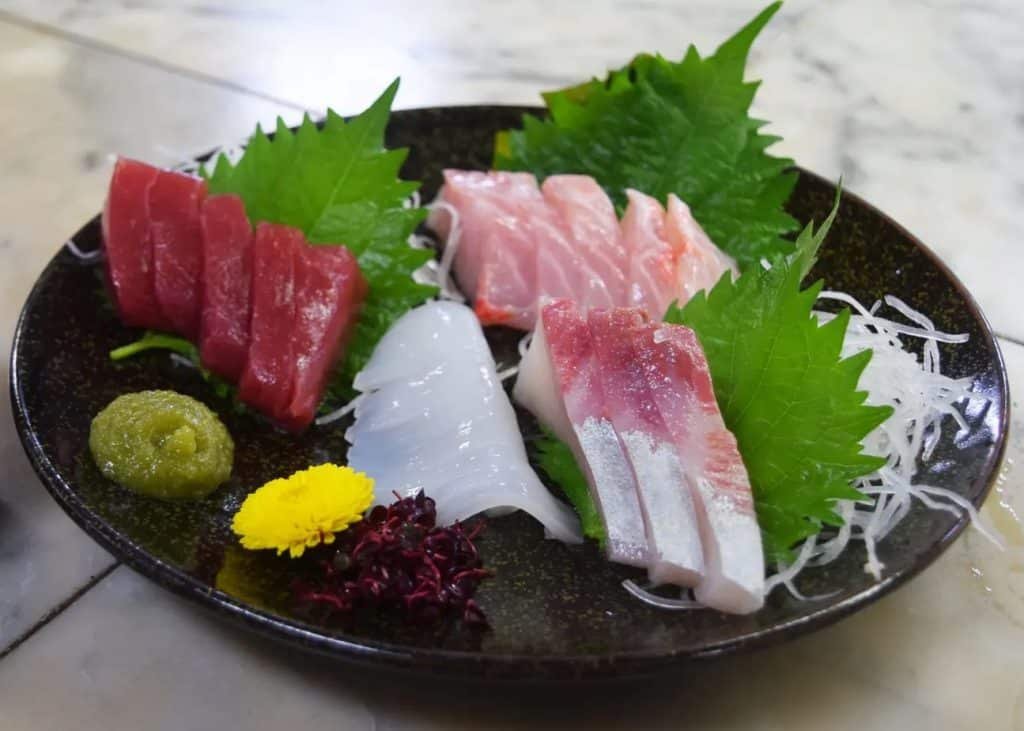
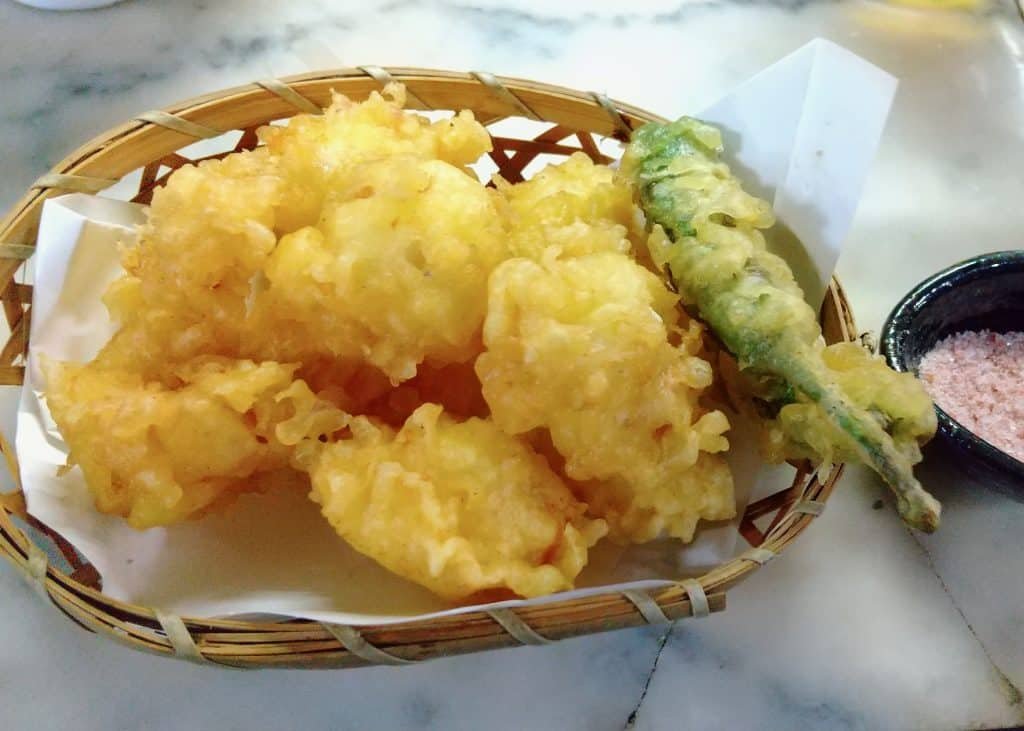
I was excited to see one of my favorite old-school izakaya dishes on the menu: tako (octopus) tempura. I tended to avoid octopus out of ignorance when I first came to Japan and that included shunning takoyaki until I finally saw the light. That all changed when I discovered octopus tempura at my local izakaya, which soon became my go-to order. The tako tempura at Senryo might be the best I have ever had in Japan. Now I understand why some of the regulars travel wide and far just to order the delicious tempura.
Udon Noodles and Tebasaki Chicken Wings
When I first came to Japan as a student in the late 80s I used to look forward to stopping off at a tiny place under the station for a 200 yen bowl of udon or soba. Over the years I found myself eating udon and soba less frequently for some reason. Having read about the delicious dashi broth at Senryo, I decided that it was high time to get reacquainted with udon for the first time in what seemed like ages. The tempura udon with its rich dashi broth brought back sensory memories back to my student days.
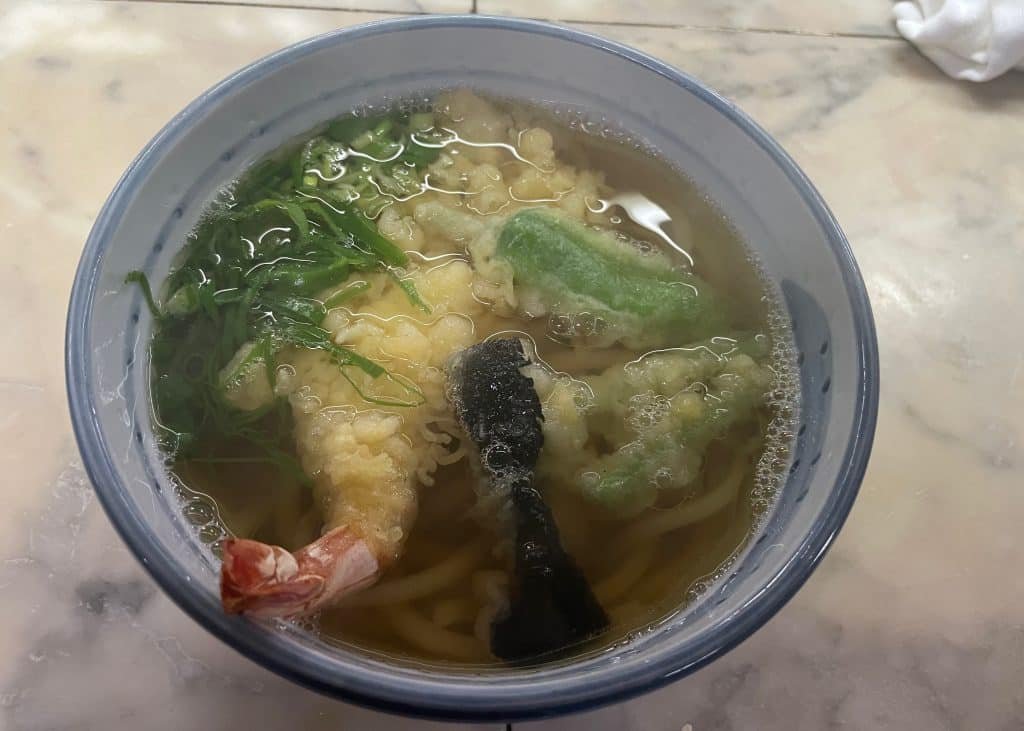
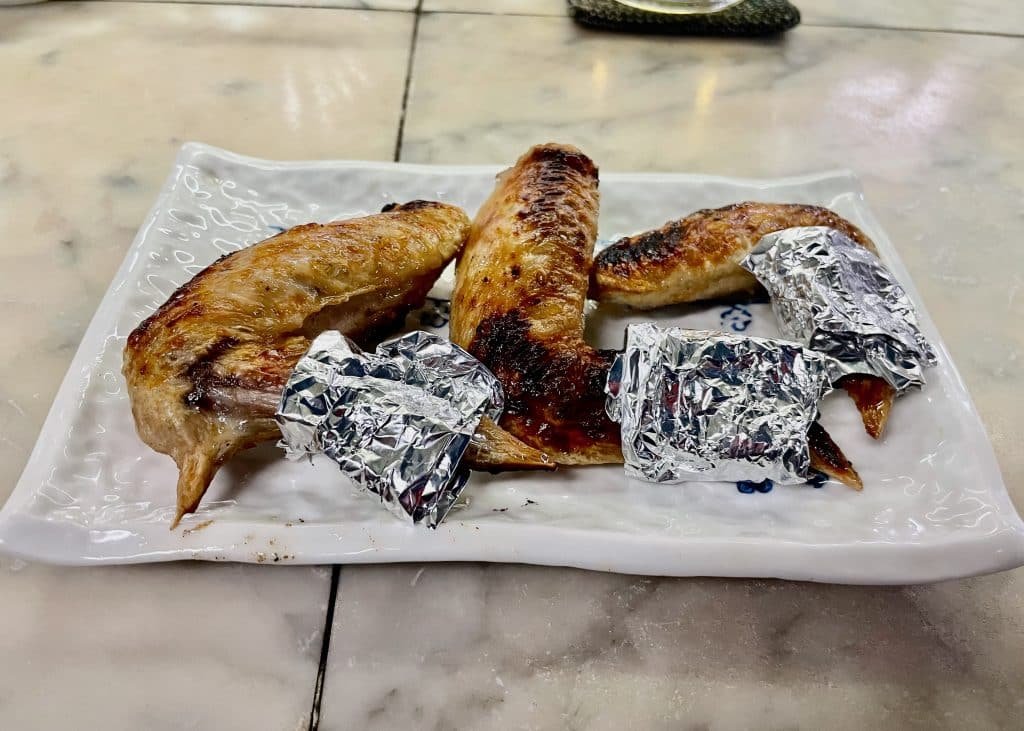
We also got the tebasaki fried chicken wings, which was glazed with a sweet and savory sauce. I liked how the tips were wrapped in tin foil to avoid staining your fingers with chicken grease. My clothes have so battle scars from eating out in Osaka that I have started to dress in all black to avoid the inevitable stains one acquires from eating with gusto.
Red Clam Sashimi and Chicken Gizzards
My wife ordered akagai (red clam or ark shell), a red-orange shellfish that lives buried in the shallow muddy floors of inner bays from Hokkaido to Kyushu. It was garnished with, daikon white-radish strings called tsuma, wakame green seaweed, a bright-yellow chrysanthemum, an a green shiso leaf and purple shiso sprouts with a dab of wasabi. She also got senzuri, chicken gizzards, which has a chewy texture and is rich in Vitamin B. Squeeze lemon juice over this dish and you are in for a treat. I’m glad my wife came along because I would have never spotted these items on the menu.
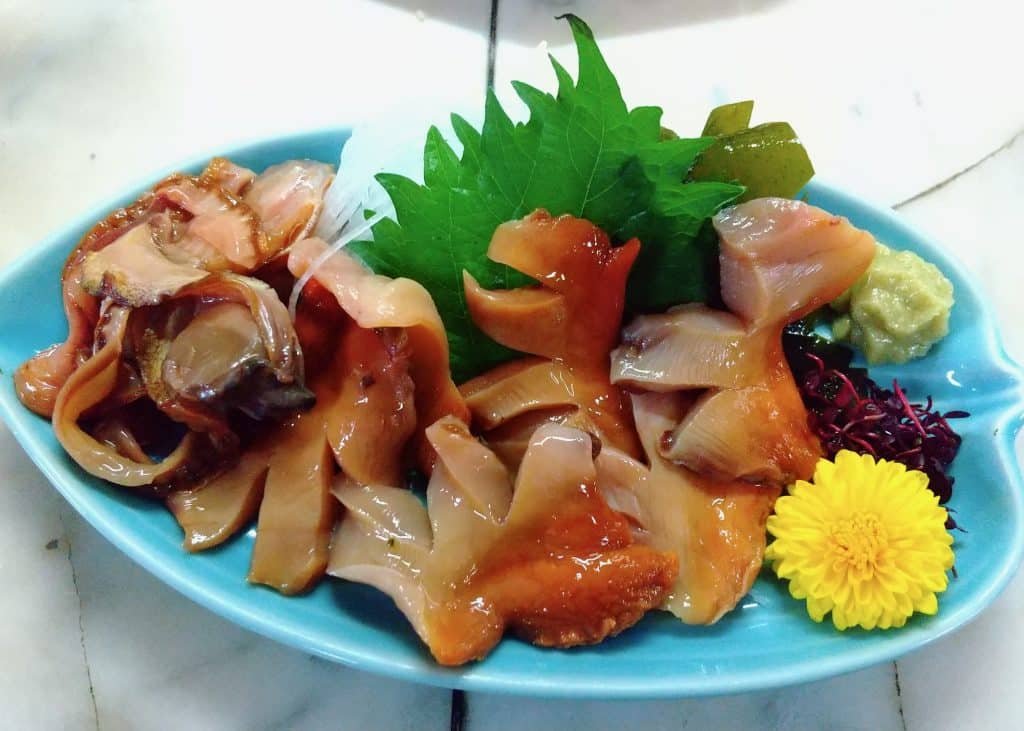
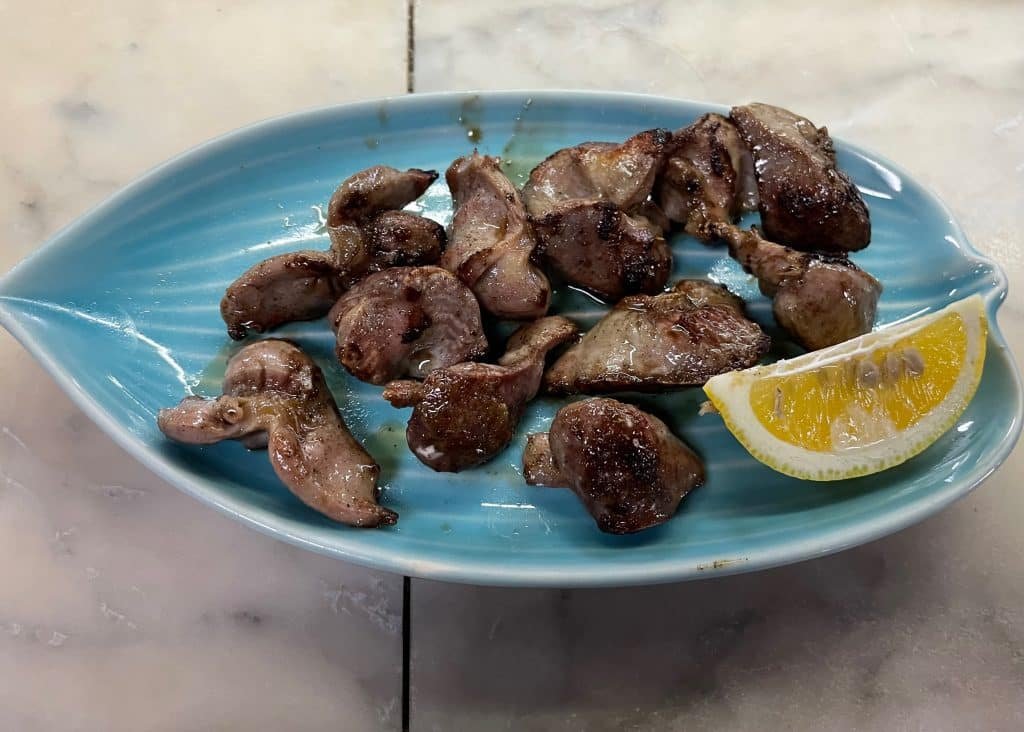
Squid Tentacle Tempura and Deep Fried Pork Cutlets
Even though I’ve been going to izakaya all over Japan for over three decades, there are still standard menu items that still surprise me. I have to admit that I didn’t know what geso (squid tentacles) was five years ago until I saw a friend order deep fried geso karaage. . Chefs in Japan prefer to use the entire part of a fish to avoid food waste, which also applies to squid. As seen in the photo of the sashimi moriawase set above, squid is a gorgeous white meat that, when fried, makes a wonderful appetizer that pairs well with a cold beer. Geso karaage has become a favorite but I had never noticed geso tempura on the menu before. The latter is made with a thicker batter that retains the chewy texture of the tentacles.
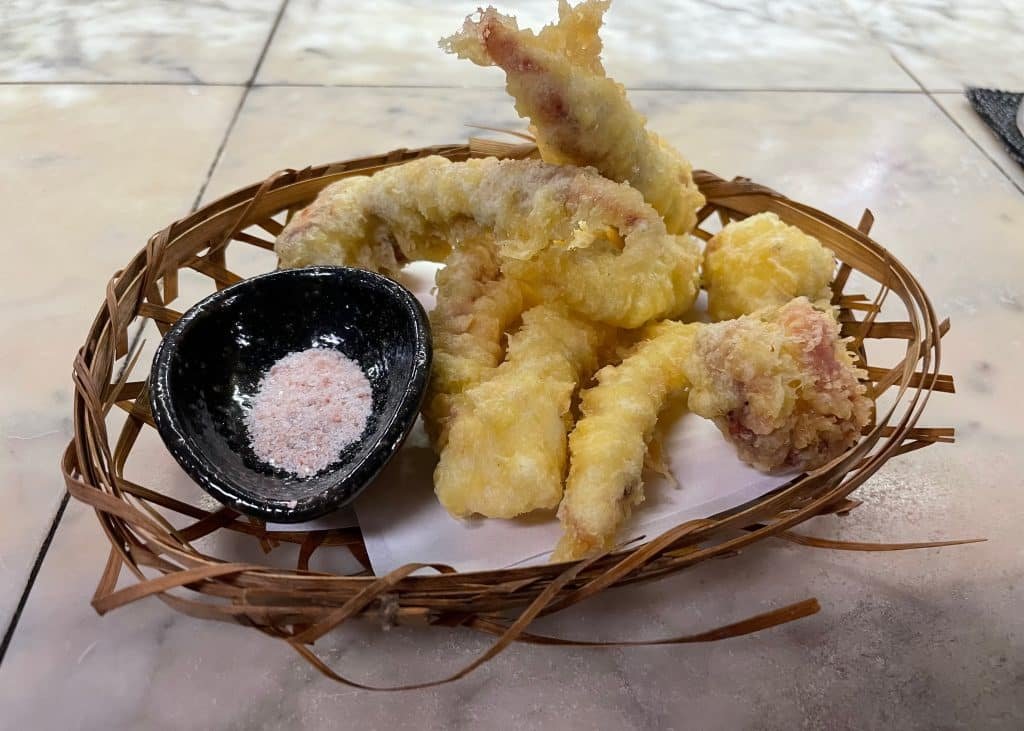
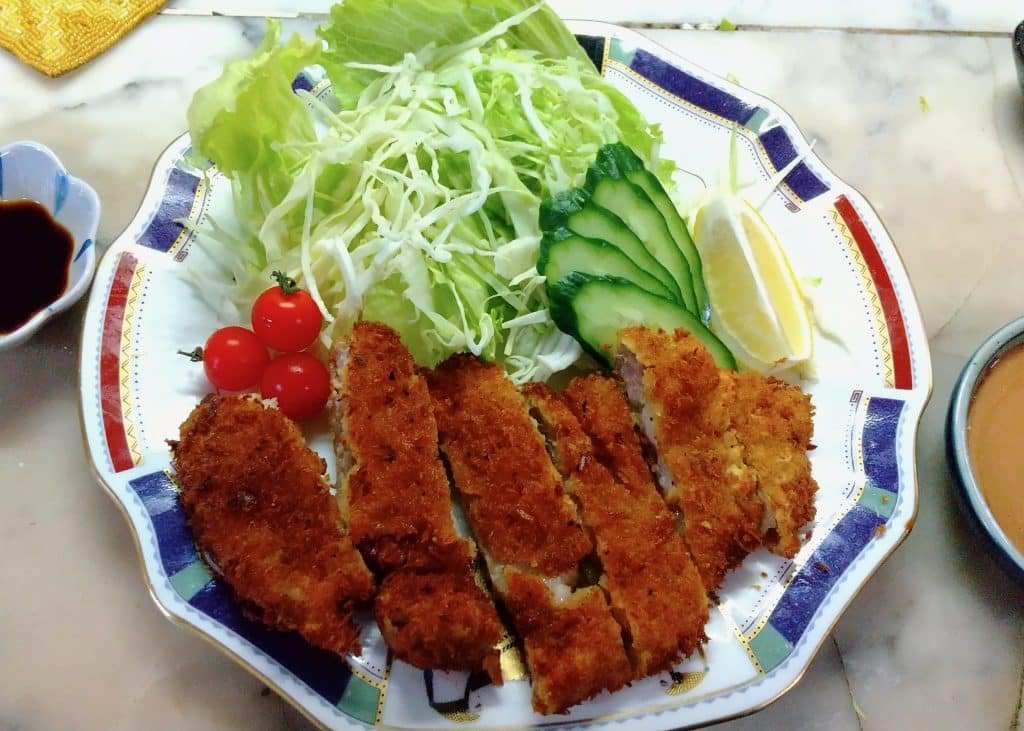
Japanese deep fried pork cutlets have become very popular abroad in recent years, so I couldn’t leave Senryo without ordering it from the menu. I could say that I was surprised by their take on this ultimate comfort food, but it tasted exactly how I expected it to taste—and that my friends is a good thing.
I’ve recently become a fan of young chefs at neo izakaya, which have become recognized for putting their own touch on classic menu items, but when I visit an old neighborhood spot like this, I want the original, not the remixed 2.0 version. I feel the same way about other meals like oyako domburi and Showa-style curry and rice, so it’s assuring to realize that throughout this exciting wave of inventive experimentation, you can always fall back on the familiar nostalgic taste of an old favorite.
Beef Croquettes and Kampachi
Speaking of old favorites, who doesn’t love korokke, potato and meat croquettes? Allow me to answer my own rhetorical question. I have actually had a bad experience with korokke the last time I ordered it from a specialty shop because the oil oozed out and stained one of my favorite items a vintage Big Black t-shirt that I purchased in 1993. I know I wrote that I started wearing black to avoid stains on my clothing, but the grease managed to leave a noticeable stain that took forever to get out. Senryo serves korokke the right way: crisp, tasty and devoid of an oil spill that would rival the Exxon Valdez.
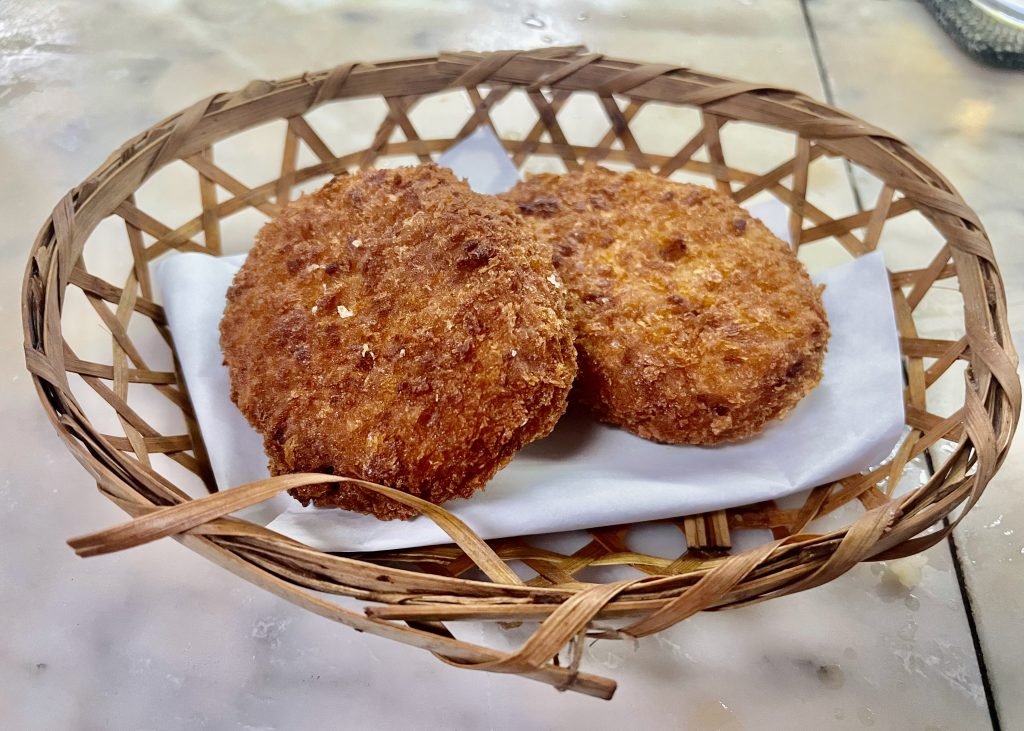
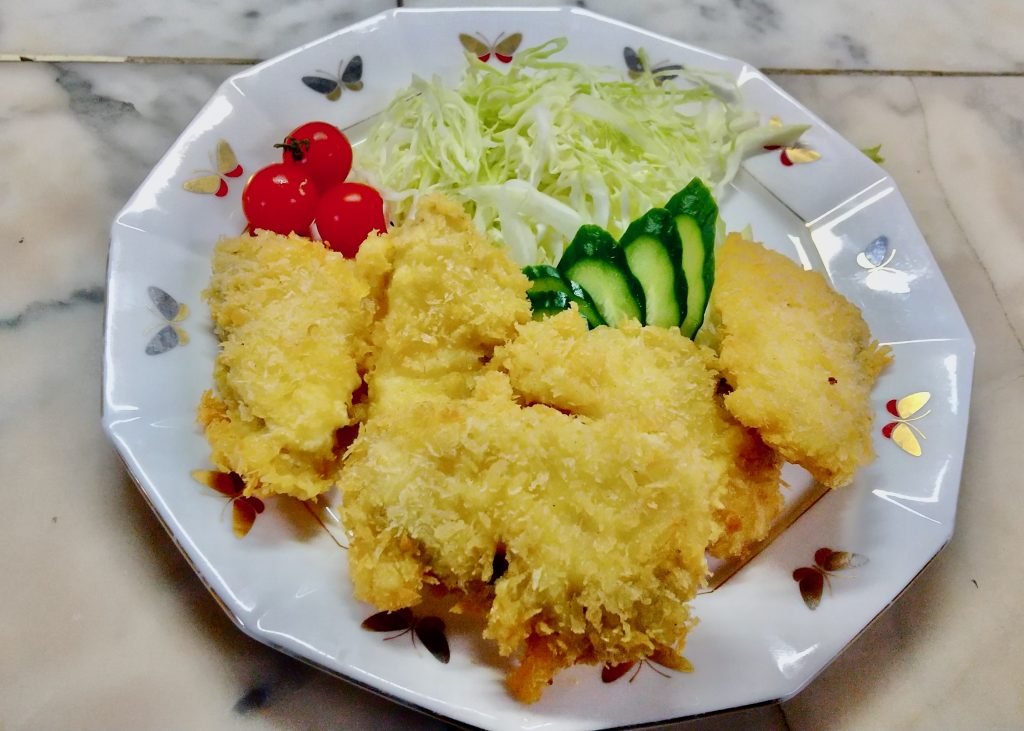
I was about to order aji fry (fried horse mackerel), but my wife wisely stopped be because she noticed kampachi fry (greater amberjack) on the menu. When kanpachi (勘八) is young, the markings on the head look like the character in Japanese “hachi” (八), which means “eight.” Kanpachi can grow up to two meters and the shape of the body is similar to buri (young yellowtail). It migrates from Aomori to Kyushu on the Japan Sea side. Kanpachi nigiri sushi has a light pink flesh with a sweetness in oozing fat. When breaded and fried it has a robust flavor with a noticeable kick. I liked kanpachi so much that I ordered it at an izakaya in Morishoji a few months later.
Bookmark….and Go!
I’m sure some readers who have come to the end of this article will bookmark it and make plans to go. I did the same when reading one of the few articles about Senryo on the Internet in Japanese, but it took a couple of years before my wife and I actually made the plunge. When we finished our meal we wished we had visited much earlier. You can find other novel bars and restaurants in Osaka such as the “secret” submarine bar or the bootleg Star Wars toy bar in which the atmosphere is a major reason to go. Do not hesitate to visit Senryo in Matsubara if you have the chance.
Author’s Note: A 2019 article on Retty News (Japanese) was used as a source for this article.
